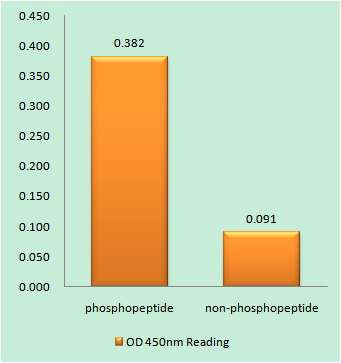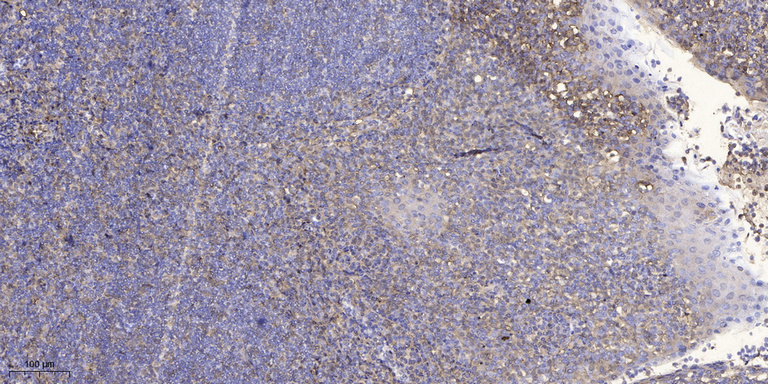PRAS40 (phospho Thr246) Polyclonal Antibody
- Catalog No.:YP0302
- Applications:WB;IHC;IF;ELISA
- Reactivity:Human;Mouse;Rat
- Target:
- PRAS40
- Fields:
- >>Autophagy - animal;>>mTOR signaling pathway;>>AMPK signaling pathway;>>Longevity regulating pathway;>>Longevity regulating pathway - multiple species;>>Thermogenesis;>>Shigellosis
- Gene Name:
- AKT1S1
- Protein Name:
- Proline-rich AKT1 substrate 1
- Human Gene Id:
- 84335
- Human Swiss Prot No:
- Q96B36
- Mouse Gene Id:
- 67605
- Mouse Swiss Prot No:
- Q9D1F4
- Immunogen:
- The antiserum was produced against synthesized peptide derived from human Akt1 S1 around the phosphorylation site of Thr246. AA range:207-256
- Specificity:
- Phospho-PRAS40 (T246) Polyclonal Antibody detects endogenous levels of PRAS40 protein only when phosphorylated at T246.
- Formulation:
- Liquid in PBS containing 50% glycerol, 0.5% BSA and 0.02% sodium azide.
- Source:
- Polyclonal, Rabbit,IgG
- Dilution:
- WB 1:500 - 1:2000. ELISA: 1:10000.. IF 1:50-200
- Purification:
- The antibody was affinity-purified from rabbit antiserum by affinity-chromatography using epitope-specific immunogen.
- Concentration:
- 1 mg/ml
- Storage Stability:
- -15°C to -25°C/1 year(Do not lower than -25°C)
- Other Name:
- AKT1S1;PRAS40;Proline-rich AKT1 substrate 1;40 kDa proline-rich AKT substrate
- Observed Band(KD):
- 40kD
- Background:
- AKT1S1 is a proline-rich substrate of AKT (MIM 164730) that binds 14-3-3 protein (see YWHAH, MIM 113508) when phosphorylated (Kovacina et al., 2003 [PubMed 12524439]).[supplied by OMIM, Mar 2008],
- Function:
- function:May play an important role in phosphatidylinositol 3-kinase (PI3K)-AKT1 survival signaling. Substrate for AKT1 phosphorylation, but can also be activated by AKT1-independent mechanisms. Its role in survival signaling pathways may be modulated by oxidative stress. May also play a role in nerve growth factor-mediated neuroprotection.,subcellular location:Found in the cytosolic fraction of the brain.,subunit:The phosphorylated form interacts with 14-3-3.,tissue specificity:Widely expressed with highest levels of expression in liver and heart. Expressed at higher levels in cancer cell lines (e.g. A549 and HeLa) than in normal cell lines (e.g. HEK293).,
- Subcellular Location:
- Cytoplasm, cytosol . Found in the cytosolic fraction of the brain. .
- Expression:
- Widely expressed with highest levels of expression in liver and heart. Expressed at higher levels in cancer cell lines (e.g. A-549 and HeLa) than in normal cell lines (e.g. HEK293).
- June 19-2018
- WESTERN IMMUNOBLOTTING PROTOCOL
- June 19-2018
- IMMUNOHISTOCHEMISTRY-PARAFFIN PROTOCOL
- June 19-2018
- IMMUNOFLUORESCENCE PROTOCOL
- September 08-2020
- FLOW-CYTOMEYRT-PROTOCOL
- May 20-2022
- Cell-Based ELISA│解您多样本WB检测之困扰
- July 13-2018
- CELL-BASED-ELISA-PROTOCOL-FOR-ACETYL-PROTEIN
- July 13-2018
- CELL-BASED-ELISA-PROTOCOL-FOR-PHOSPHO-PROTEIN
- July 13-2018
- Antibody-FAQs
- Products Images

- Enzyme-Linked Immunosorbent Assay (Phospho-ELISA) for Immunogen Phosphopeptide (Phospho-left) and Non-Phosphopeptide (Phospho-right), using Akt1 S1 (Phospho-Thr246) Antibody

- Western blot analysis of lysates from HepG2 cells treated with PDGF 50ng/ml 30', using Akt1 S1 (Phospho-Thr246) Antibody. The lane on the right is blocked with the phospho peptide.

- Immunohistochemical analysis of paraffin-embedded human tonsil. 1, Antibody was diluted at 1:200(4° overnight). 2, Tris-EDTA,pH9.0 was used for antigen retrieval. 3,Secondary antibody was diluted at 1:200(room temperature, 30min).
